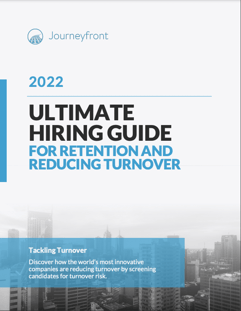Hiring is hard. Hiring people that will stay in a position for a long time is even harder. Here are five questions guaranteed to flag a candidate for turnover risk and thus help you reduce employee turnover.
1. General Life & Career Satisfaction
|
Interview Question: On a scale of 1-10, how satisfied would you say you are with your career right now, and why? |
Why This Question Helps Screen For Turnover: General life & career Satisfaction is on of the biggest driving factors of employee turnover. Gauging how satisfied a candidate is with their current career, and life in general, will tell you a lot about how they will react in the future.
How Score the Question: They key to this question is to gauge the overall level of positivity or negativity of the candidate. Research has shown an overall positive perspective on life and one’s career translates directly into higher retention on the job. Score candidates with more positives attitudes higher then those with negative attitudes.
2. Coping Ability
|
Interview Question: Tell me about a time you experienced burn-out. What caused it? How did you handle it? |
Why This Question Helps Screen For Turnover: A persons ability to manage internal and external demands that are perceived as exceeding available resources (coping ability), has been found to directly correlate with employee turnover. The better a person is at coping with stressful situations the more likely they are to stay at a job.
How to Score the Question: Look for evidence that this person can juggle multiple hard things. The more difficult the demands placed upon them (both internal and external to a job) and the greater the evidence that they were able to manage those demands, the greater the likelihood that they can do the same at your company. As a follow up, how the candidate responded to that trying time can be confirmed via a reference call.
3. General Career Commitment
|
Interview Question: What are the largest sacrifices you have made thus far for your career? |
Why This Question Helps Screen For Turnover: The past is the best predictor for the future, and a person who can demonstrate above average commitment to the success of his/her career is more likely to bring that same commitment to you at your organization. Research has shown this trait to be highly correlated with retention.
How to Score the Question: Look at the size of the sacrifice each candidate has made for their career. The larger the sacrifice, the more likely they are to be committed to your company, assuming they are a fit for the role.
4. Job Fit
|
Interview Question: Can you tell me the 3 main reasons you have left jobs in the past? |
Why This Question Helps Screen For Turnover: The compatibility between an individual and a work environment that occurs when their characteristics are well matched (job fit) is another highly correlated attribute of employee turnover. The better the job fit, the more likely the person is to stay at a job.
How to Score the Question: Look for themes for their leaving prior jobs that are likely to apply to the current job environment. For example, if a person has left a job in the past due to a lack of opportunity, follow-up questioning may reveal whether they’ll encounter those same kinds of issues in the role they’d be assuming at your company. Look for reasons that might cause them to leave the job they are being interviewed for.
5. Organizational Commitment:
|
Interview Question: Why did you apply for this position ? |
Why This Question Helps Screen For Turnover: The degree to which an individual experiences loyalty to the organization and desires to stay. Includes all three facets of organizational commitment: affective (a desire to stay), normative (an obligation to stay), and continuance (a need to stay) commitment. People stay in jobs and at companies when they have a commitment to more than just themselves. Finding people who are likely to commit to the organization will reduce employee turnover.
How to Score the Question: You’re looking for as much candidate alignment with the organization and what it does as possible. This could come in the form of an affinity for the company’s product, a passion for its mission, or a host of other potential attractions. All can serve as evidence to some degree that the person is more likely to stay once hired.
The above are a few examples of interview questions you can use today to reduce turnover at your company. We hope you have found them useful and can start using them to get a better gauge of who if the right candidate for positions at your company. Viewing the candidate evaluation process through the lens of retention-related criteria can transform the way you interpret the candidate’s response.
Interested on how much turnover is costing your company? Click here to download our turnover calculator.
Please contact us at contact@journeyfront.com if you’d like to discover other research-backed examples in addition to what’s above.
Enjoy this article? This is a small portion of our hiring guide "The Ultimate Hiring Guide for Reducing Turnover." Take a look!
Click here to download the complete guide





.webp?height=199&name=interview-614186261c9a9153d1616ca96be3ef683f65544215d16530ad22c367c5623873%20(1).webp)
